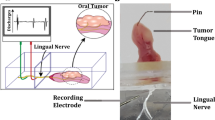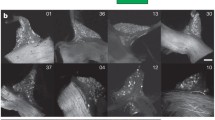Abstract
The chemoreception of dietary fat in the oral cavity has largely been attributed to activation of the somatosensory system that conveys the textural properties of fat. However, the ability of fatty acids, which are believed to represent the proximate stimulus for fat taste, to stimulate rat trigeminal neurons has remained unexplored. Here, we found that several free fatty acids are capable of activating trigeminal neurons with different kinetics. Further, a polyunsaturated fatty acid, linoleic acid (LA), activates trigeminal neurons by increasing intracellular calcium concentration and generating depolarizing receptor potentials. Ion substitution and pharmacological approaches reveal that intracellular calcium store depletion is crucial for LA-induced signaling in a subset of trigeminal neurons. Using pseudorabies virus (PrV) as a live cell tracer, we identified a subset of lingual nerve-innervated trigeminal neurons that respond to different subsets of fatty acids. Quantitative real-time PCR of several transient receptor potential channel markers in individual neurons validated that PrV labeled a subset but not the entire population of lingual-innervated trigeminal neurons. We further confirmed that the LA-induced intracellular calcium rise is exclusively coming from the release of calcium stores from the endoplasmic reticulum in this subset of lingual nerve-innervated trigeminal neurons.





Similar content being viewed by others
References
Abumrad NA (2005) CD36 may determine our desire for dietary fats. J Clin Invest 115(11):2965–2967
Baillie AG, Coburn CT, Abumrad NA (1996) Reversible binding of long-chain fatty acids to purified FAT, the adipose CD36 homolog. J Membr Biol 153(1):75–81
Bautista DM, Movahed P, Hinman A, Axelsson HE, Sterner O, Hogestatt ED, Julius D, Jordt SE, Zygmunt PM (2005) Pungent products from garlic activate the sensory ion channel TRPA1. Proc Natl Acad Sci U S A 102(34):12248–12252
Bautista DM, Siemens J, Glazer JM, Tsuruda PR, Basbaum AI, Stucky CL, Jordt SE, Julius D (2007) The menthol receptor TRPM8 is the principal detector of environmental cold. Nature 448(7150):204–208
Bautista DM, Sigal YM, Milstein AD, Garrison JL, Zorn JA, Tsuruda PR, Nicoll RA, Julius D (2008) Pungent agents from Szechuan peppers excite sensory neurons by inhibiting two-pore potassium channels. Nat Neurosci 11(7):772–779
Bhattacharya MR, Bautista DM, Wu K, Haeberle H, Lumpkin EA, Julius D (2008) Radial stretch reveals distinct populations of mechanosensitive mammalian somatosensory neurons. Proc Natl Acad Sci U S A 105(50):20015–20020
Bray GA, Popkin BM (1998) Dietary fat intake does affect obesity! Am J Clin Nutr 68(6):1157–1173
Bray GA, Popkin BM (1999) Dietary fat affects obesity rate. Am J Clin Nutr 70(4):572–573
Briscoe CP, Tadayyon M, Andrews JL, Benson WG, Chambers JK, Eilert MM, Ellis C, Elshourbagy NA, Goetz AS, Minnick DT, Murdock PR, Sauls HR Jr, Shabon U, Spinage LD, Strum JC, Szekeres PG, Tan KB, Way JM, Ignar DM, Wilson S, Muir AI (2003) The orphan G protein-coupled receptor GPR40 is activated by medium and long chain fatty acids. J Biol Chem 278(13):11303–11311
Brown AJ, Goldsworthy SM, Barnes AA, Eilert MM, Tcheang L, Daniels D, Muir AI, Wigglesworth MJ, Kinghorn I, Fraser NJ, Pike NB, Strum JC, Steplewski KM, Murdock PR, Holder JC, Marshall FH, Szekeres PG, Wilson S, Ignar DM, Foord SM, Wise A, Dowell SJ (2003) The Orphan G protein-coupled receptors GPR41 and GPR43 are activated by propionate and other short chain carboxylic acids. J Biol Chem 278(13):11312–11319
Calder PC, Deckelbaum RJ (2006) CD36: taste the difference? Curr Opin Clin Nutr Metab Care 9(2):77–78
Card JP, Enquist LW (2001) Transneuronal circuit analysis with pseudorabies viruses. Curr Protoc Neurosci Chapter 1:Unit 15
Card JP, Rinaman L, Schwaber JS, Miselis RR, Whealy ME, Robbins AK, Enquist LW (1990) Neurotropic properties of pseudorabies virus: uptake and transneuronal passage in the rat central nervous system. J Neurosci 10(6):1974–1994
Cartoni C, Yasumatsu K, Ohkuri T, Shigemura N, Yoshida R, Godinot N, le Coutre J, Ninomiya Y, Damak S (2010) Taste preference for fatty acids is mediated by GPR40 and GPR120. J Neurosci 30(25):8376–8382
Caterina MJ, Schumacher MA, Tominaga M, Rosen TA, Levine JD, Julius D (1997) The capsaicin receptor: a heat-activated ion channel in the pain pathway. Nature 389(6653):816–824
Chaudhari N, Roper SD (2010) The cell biology of taste. J Cell Biol 190(3):285–296
Damann N, Rothermel M, Klupp BG, Mettenleiter TC, Hatt H, Wetzel CH (2006) Chemosensory properties of murine nasal and cutaneous trigeminal neurons identified by viral tracing. BMC Neurosci. doi:10.1186/1471-2202-7-46
Drewnowski A, Greenwood MR (1983) Cream and sugar: human preferences for high-fat foods. Physiol Behav 30(4):629–633
Everaerts W, Gees M, Alpizar YA, Farre R, Leten C, Apetrei A, Dewachter I, van Leuven F, Vennekens R, De Ridder D, Nilius B, Voets T, Talavera K (2011) The capsaicin receptor TRPV1 is a crucial mediator of the noxious effects of mustard oil. Curr Biol 21(4):316–321
Fukuwatari T, Kawada T, Tsuruta M, Hiraoka T, Iwanaga T, Sugimoto E, Fushiki T (1997) Expression of the putative membrane fatty acid transporter (FAT) in taste buds of the circumvallate papillae in rats. FEBS Lett 414(2):461–464
Gilbertson TA, Fontenot DT, Liu L, Zhang H, Monroe WT (1997) Fatty acid modulation of K + channels in taste receptor cells: gustatory cues for dietary fat. Am J Physiol 272(4 Pt 1):C1203–1210
Gilbertson TA, Liu L, Kim I, Burks CA, Hansen DR (2005) Fatty acid responses in taste cells from obesity-prone and -resistant rats. Physiol Behav 86(5):681–690
Gilbertson TA, Liu L, York DA, Bray GA (1998) Dietary fat preferences are inversely correlated with peripheral gustatory fatty acid sensitivity. Ann N Y Acad Sci 855:165–168
Gilbertson TA, Yu T, Shah BP (2010) Gustatory mechanisms for fat detection. In: Montmayeur J-P, le-Coutre J (eds) Fat detection: taste, texture, and post ingestive effects. Taylor & Francis, Boca Raton, pp 83–104
Hirasawa A, Hara T, Katsuma S, Adachi T, Tsujimoto G (2008) Free fatty acid receptors and drug discovery. Biol Pharm Bull 31(10):1847–1851
Hirasawa A, Tsumaya K, Awaji T, Katsuma S, Adachi T, Yamada M, Sugimoto Y, Miyazaki S, Tsujimoto G (2005) Free fatty acids regulate gut incretin glucagon-like peptide-1 secretion through GPR120. Nat Med 11(1):90–94
Itoh Y, Kawamata Y, Harada M, Kobayashi M, Fujii R, Fukusumi S, Ogi K, Hosoya M, Tanaka Y, Uejima H, Tanaka H, Maruyama M, Satoh R, Okubo S, Kizawa H, Komatsu H, Matsumura F, Noguchi Y, Shinohara T, Hinuma S, Fujisawa Y, Fujino M (2003) Free fatty acids regulate insulin secretion from pancreatic beta cells through GPR40. Nature 422(6928):173–176
Jordt SE, Bautista DM, Chuang HH, McKemy DD, Zygmunt PM, Hogestatt ED, Meng ID, Julius D (2004) Mustard oils and cannabinoids excite sensory nerve fibres through the TRP channel ANKTM1. Nature 427(6971):260–265
Jordt SE, Julius D (2002) Molecular basis for species-specific sensitivity to "hot" chili peppers. Cell 108(3):421–430
Karashima Y, Damann N, Prenen J, Talavera K, Segal A, Voets T, Nilius B (2007) Bimodal action of menthol on the transient receptor potential channel TRPA1. J Neurosci 27(37):9874–9884
Kinnamon SC (2011) Taste receptor signalling—from tongues to lungs. Acta Physiol (Oxf). doi:10.1111/j.1748-1716.2011.02308.x
Laugerette F, Passilly-Degrace P, Patris B, Niot I, Febbraio M, Montmayeur JP, Besnard P (2005) CD36 involvement in orosensory detection of dietary lipids, spontaneous fat preference, and digestive secretions. J Clin Invest 115(11):3177–3184
Liou AP, Lu X, Sei Y, Zhao X, Pechhold S, Carrero RJ, Raybould HE, Wank S (2011) The G-protein-coupled receptor GPR40 directly mediates long-chain fatty acid-induced secretion of cholecystokinin. Gastroenterology 140(3):903–912
Liu L, Chang GQ, Jiao YQ, Simon SA (1998) Neuronal nicotinic acetylcholine receptors in rat trigeminal ganglia. Brain Res 809(2):238–245
Liu L, Simon SA (2000) Capsaicin, acid and heat-evoked currents in rat trigeminal ganglion neurons: relationship to functional VR1 receptors. Physiol Behav 69(3):363–378
Liu P, Shah BP, Croasdell S, Gilbertson TA (2011) Transient receptor potential channel type m5 is essential for fat taste. J Neurosci 31(23):8634–8642
Matsumura S, Mizushige T, Yoneda T, Iwanaga T, Tsuzuki S, Inoue K, Fushiki T (2007) GPR expression in the rat taste bud relating to fatty acid sensing. Biomed Res 28(1):49–55
Mattes RD (2010) Fat taste in humans: is it a primary? In: Montmayeur J-P, le-Coutre J (eds) Fat detection: taste, texture, and post ingestive effects. Taylor & Francis, Boca Raton, pp 167–193
McCarthy KM, Tank DW, Enquist LW (2009) Pseudorabies virus infection alters neuronal activity and connectivity in vitro. PLoS Pathog 5(10):e1000640. doi:10.1371/journal.ppat.1000640
McKemy DD, Neuhausser WM, Julius D (2002) Identification of a cold receptor reveals a general role for TRP channels in thermosensation. Nature 416(6876):52–58
Milligan G, Stoddart LA, Brown AJ (2006) G protein-coupled receptors for free fatty acids. Cell Signal 18(9):1360–1365
Mizushige T, Inoue K, Fushiki T (2007) Why is fat so tasty? Chemical reception of fatty acid on the tongue. J Nutr Sci Vitaminol (Tokyo) 53(1):1–4
Peier AM, Moqrich A, Hergarden AC, Reeve AJ, Andersson DA, Story GM, Earley TJ, Dragoni I, McIntyre P, Bevan S, Patapoutian A (2002) A TRP channel that senses cold stimuli and menthol. Cell 108(5):705–715
Perez CA, Stanley SA, Wysocki RW, Havranova J, Ahrens-Nicklas R, Onyimba F, Friedman JM (2011) Molecular annotation of integrative feeding neural circuits. Cell Metab 13(2):222–232
Rayasam GV, Tulasi VK, Davis JA, Bansal VS (2007) Fatty acid receptors as new therapeutic targets for diabetes. Expert Opin Ther Targets 11(5):661–671
Rolls ET, Critchley HD, Browning AS, Hernadi I, Lenard L (1999) Responses to the sensory properties of fat of neurons in the primate orbitofrontal cortex. J Neurosci 19(4):1532–1540
Rothermel M, Schobel N, Damann N, Klupp BG, Mettenleiter TC, Hatt H, Wetzel CH (2007) Anterograde transsynaptic tracing in the murine somatosensory system using Pseudorabies virus (PrV): a "live-cell"-tracing tool for analysis of identified neurons in vitro. J Neurovirol 13(6):579–585
Sclafani A, Ackroff K, Abumrad NA (2007) CD36 gene deletion reduces fat preference and intake but not post-oral fat conditioning in mice. Am J Physiol Regul Integr Comp Physiol 293(5):R1823–1832
Sprous D, Palmer KR (2010) The T1R2/T1R3 sweet receptor and TRPM5 ion channel taste targets with therapeutic potential. Prog Mol Biol Transl Sci 91:151–208
Story GM, Peier AM, Reeve AJ, Eid SR, Mosbacher J, Hricik TR, Earley TJ, Hergarden AC, Andersson DA, Hwang SW, McIntyre P, Jegla T, Bevan S, Patapoutian A (2003) ANKTM1, a TRP-like channel expressed in nociceptive neurons, is activated by cold temperatures. Cell 112(6):819–829
Verhagen JV, Rolls ET, Kadohisa M (2003) Neurons in the primate orbitofrontal cortex respond to fat texture independently of viscosity. J Neurophysiol 90(3):1514–1525
Wang J, Wu X, Simonavicius N, Tian H, Ling L (2006) Medium-chain fatty acids as ligands for orphan G protein-coupled receptor GPR84. J Biol Chem 281(45):34457–34464
Wang YY, Chang RB, Liman ER (2010) TRPA1 is a component of the nociceptive response to CO2. J Neurosci 30(39):12958–12963
Yang KT, Chen WP, Chang WL, Su MJ, Tsai KL (2005) Arachidonic acid inhibits capacitative Ca2+ entry and activates non-capacitative Ca2+ entry in cultured astrocytes. Biochem Biophys Res Commun 331(2):603–613
Zaibi MS, Stocker CJ, O'Dowd J, Davies A, Bellahcene M, Cawthorne MA, Brown AJ, Smith DM, Arch JR (2010) Roles of GPR41 and GPR43 in leptin secretory responses of murine adipocytes to short chain fatty acids. FEBS Lett 584(11):2381–238
Acknowledgments
The project described was partially supported by award number R01DK059611 (T.A.G.) from the National Institute of Diabetes and Digestive and Kidney Diseases. The content is solely the responsibility of the authors and does not necessarily represent the official views of the National Institute of Diabetes and Digestive and Kidney Diseases or the National Institutes of Health. Additional support was provided by project #630 from the Utah Agricultural Experiment Station and from International Flavors & Fragrances.
Author information
Authors and Affiliations
Corresponding author
Rights and permissions
About this article
Cite this article
Yu, T., Shah, B.P., Hansen, D.R. et al. Activation of oral trigeminal neurons by fatty acids is dependent upon intracellular calcium. Pflugers Arch - Eur J Physiol 464, 227–237 (2012). https://doi.org/10.1007/s00424-012-1116-9
Received:
Revised:
Accepted:
Published:
Issue Date:
DOI: https://doi.org/10.1007/s00424-012-1116-9




